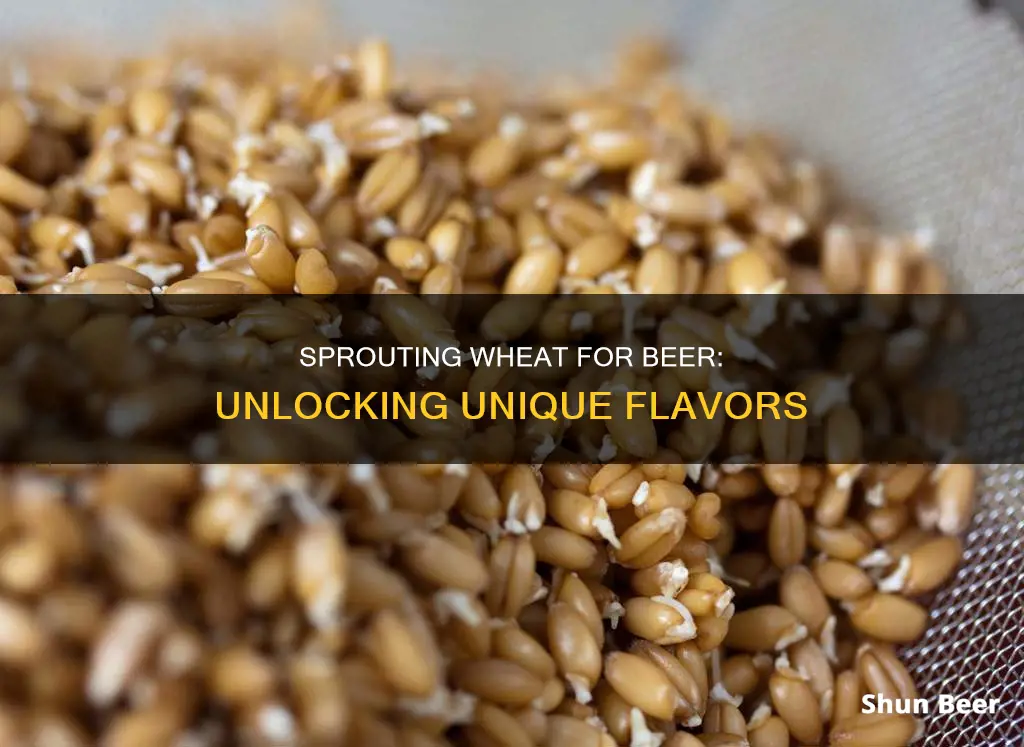
Sprouting wheat grains is the first step in the process of making beer. This involves moistening the grain and prompting germination to produce the enzymes that will convert starches to sugars. The grain is usually barley, which in its raw form is packed with starch. To turn that starch into sugars, which yeast will then turn into alcohol, the barley is malted. The maltster then bakes the grain in a kiln, arresting the germination.
What You'll Learn
- Sprouting wheat produces enzymes that convert starches to sugars
- Sprouting wheat before malting can affect the flavour of the beer
- Wheat is used in beer for its soft, crisp flavour
- Wheat beers are often hazy with proteins and offer a distinct contrast to the brightly filtered industrial brews
- Wheat beers are popular in summer

Sprouting wheat produces enzymes that convert starches to sugars
Sprouting wheat is an important step in the process of making beer. It involves carefully halting the growth of barley seeds to produce a starch-packed kernel with enzymes that can convert starch into sugar. This process is known as malting, and it is essential for brewing beer.
During the malting process, the wheat grains undergo four main steps: steeping, germination, drying, and kilning. The first step, steeping, involves increasing the moisture content of the barley seeds to prepare them for germination. The seeds are soaked in cool water for about eight hours, drained, and then allowed to rest for several hours before being soaked again. This process is repeated until the seeds reach the optimal moisture content for germination, which is crucial for the production of enzymes that will convert starch to sugar.
Once the seeds have absorbed the right amount of water, they are ready for the germination stage. During this stage, the roots and shoots begin to emerge from the kernel, and the production of enzymes begins. The sprouting grains must be kept cool and moist to ensure proper modification. Turning the malt by hand helps to ensure even moisture distribution and temperature control. This process usually takes about 3-5 days, and it is crucial for the development of enzymes that will convert starch into sugar.
The next step in the malting process is drying. This step stops the sprouting process at the point where the starch granules have been formed and the enzymes for converting starch to sugar are present. The malted barley is dried at controlled temperatures to prevent enzyme denaturation. Initial drying is done at temperatures below 125°F (52°C) to protect the enzymes. Once the moisture content reaches the desired level, the temperature is increased to complete the drying process.
The final step in malting is kilning, which develops the color and flavor of the husks. The dried malt is heated at specific temperatures for several hours, depending on the desired color and flavor profile. This step is crucial for producing the characteristic flavors and aromas associated with different types of beer.
The process of sprouting wheat and converting starch to sugar is a complex and delicate procedure that requires careful control of temperature, moisture, and timing. It is an essential step in brewing beer, as it provides the sugars that will be fermented to produce alcohol and the desired flavor profile.
Shandy's Wheat Beer Mystery: Summ Shandy's Secret Ingredients
You may want to see also

Sprouting wheat before malting can affect the flavour of the beer
Wheat malt is often used in beer to contribute haze, add clean sweetness and body, and provide other flavour contributions. Wheat is typically malted by first steeping it in cold water, then allowing it to germinate, and finally drying it (kilning). The malting process for wheat is more challenging than for barley due to its lack of a thick husk, which causes it to absorb water more quickly and modify more rapidly.
The flavour of the beer can be influenced by the type of wheat used for malting, the degree of modification during germination, and the kilning temperature. Different varieties of wheat, such as red or white wheat, can contribute distinct flavours to the beer. For example, red wheat may contribute a nuttier flavour due to its higher level of phenolic compounds, while white wheat may result in a cleaner and sweeter flavour profile.
The degree of modification during germination can also impact the flavour. Uniformity of modification is essential to ensure that all the barley sprouts and modifies at the same pace. If the wheat is not fully modified, it can affect the enzymatic power of the malt, potentially leading to off-flavours in the beer.
Additionally, the kilning temperature plays a crucial role in flavour development. Kilning at higher temperatures can lead to the formation of melanoidins, which contribute to the "malty" flavour found in darker malts. Lower kilning temperatures are typically used for wheat malt, resulting in a slightly darker colour even in the palest wheat malt.
Overall, the process of sprouting wheat before malting can have a significant impact on the flavour of the beer. The type of wheat, degree of modification, and kilning temperature all play a role in determining the final flavour profile of the beer.
Crafting Wheat Beer: Adding Unique Flavors to Your Brew
You may want to see also

Wheat is used in beer for its soft, crisp flavour
Wheat beers are top-fermented and brewed with a large proportion of wheat relative to malted barley. The two main varieties are German Weizenbier and Belgian witbier, with other types including Lambic, Berliner Weisse, and Gose. Wheat beers are termed "white beers" because "wheat" and "white" share the same etymological root in most West Germanic languages.
The early weissbiers were known for their pale colour, and many craft brewers still offer wheat beers as their palest selection. Belgian witbiers, in particular, are made with up to 50% raw wheat rather than wheat malt, resulting in beers that are less sweet and full-bodied.
Wheat generally has more protein than barley, which increases the body and mouthfeel of the beer. Wheat also contributes to foam stability, creating a better, longer-lasting head. However, the higher protein levels can also cause problems during brewing and make the beer hazy.
Wheat brings a softer, less malty nose to beer compared to barley, with more body and mouthfeel. It has a fairly neutral flavour, sometimes with a hint of bread. Wheat ales are usually unfiltered and have a cloudy appearance due to the high protein content.
Best Wheat-Free Beers: Enjoy Without the Wheat
You may want to see also

Wheat beers are often hazy with proteins and offer a distinct contrast to the brightly filtered industrial brews
Wheat beers are also often fermented with very low-flocculating yeast and/or have yeast added to the beer to accentuate their cloudy look. Haze can also be caused by the presence of bacteria, which can add off-flavours such as sharp sourness, sulphur, and fecal flavours. However, in wheat beers, haze is nearly always a function of grist composition and not of hops usage. Wheat is more protein-heavy than barley, and several varieties will make haze much more likely. For example, unmalted wheat, which is used in witbiers, is more likely to make a beer hazy.
Haze can also be an artifact of hops usage. Hops impart polyphenols, which can be visible in beer and, given the right type and amount of hops, might add a touch of haze to the beer. Hops polyphenols tend to be even more visible when they clump together with proteins from the grain. This often happens when the beer is chilled, creating what is known as "chill haze".
Blonde Ales and Wheat Beer: What's the Connection?
You may want to see also

Wheat beers are popular in summer
Wheat beers have a long history, dating back to ancient Sumerian and Egyptian times. The style has evolved over the centuries, with different regions developing their own unique variations. For example, the Germans have their hefeweizens, which are unfiltered wheat beers with a cloudy appearance and a yeasty flavour, while the Belgians have their witbiers, which are spiced with ingredients like coriander and orange peel.
American wheat beers have also gained popularity in recent years, often drawing inspiration from German and Belgian styles while adding their own unique twists. These beers tend to showcase the flavour of wheat more prominently and often have a hint of citric acidity.
Wheat beers are a versatile style that can be crafted to suit a range of tastes and preferences. They can be hazy or clear, hoppy or malt-forward, and spiced or unspiced. This adaptability has likely contributed to their enduring popularity during the summer months when people are looking for refreshing and easy-drinking beers.
Whether it's a traditional German hefeweizen, a Belgian-style witbier, or an innovative American wheat beer, wheat beers offer a delightful balance of flavour and refreshment that is perfectly suited to the summer season.
Tiger Beer and Wheat: What's the Deal?
You may want to see also







